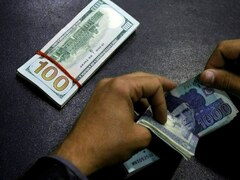SBP’s Dollar Procurement Policy Questioned
The State Bank of Pakistan’s (SBP) practice of acquiring dollars from the market, sourced from hawala hundi, to stabilize the rupee-dollar exchange rate and bolster foreign exchange reserves has been called into question. According to experts, this is not a viable long-term strategy.
This perspective was shared by Dr. Hafeez Pasha, a former finance minister, during his appearance on Aaj TV’s ‘Paisa Bolta Hai with Anjum Ibrahim’.
Dr. Pasha also highlighted the negative growth in the large-scale manufacturing (LSM) sector, coupled with declines in major agricultural crops, including a 28% drop in cotton production. He suggested that the nation is unlikely to achieve a 2% Gross Domestic Product (GDP) growth rate, falling short of the 3.5% target initially set for the current fiscal year.
Rupee Forecast
Fitch Ratings projects the Pakistani rupee to reach 285 against the US dollar by June and 295 by the end of FY26.
Incentives for Exporters
Dr. Pasha asserted that utilizing market-acquired dollars to maintain the rupee-dollar parity between 278 and 280 is unsustainable, emphasizing the need for exporter incentives. He pointed out that the government’s agreement with the International Monetary Fund (IMF) mandates exporters to pay the full 29% tax, contrasting with the previous 1% tax on total export income.
He voiced concerns over the absence of tax breaks and incentives for exporters, unlike regional competitors like India and Bangladesh. Dr. Pasha advocated for a market-based exchange rate if tax relief is not provided, noting that SBP data indicates the Real Effective Exchange Rate (REER) exceeds Rs100, suggesting an overvalued local currency.
GDP Growth Concerns
He emphasized GDP growth as a crucial economic indicator, which was approximately one percent in the first quarter of the current fiscal year. Dr. Pasha stated that the country has not achieved an average of 3% GDP growth over the past five years, marking the lowest rate in its history.
Furthermore, with a 2.5% population growth, per capita income has decreased, pushing around 44% of the population below the poverty line. The unemployment rate, previously at 6-6.5% according to labor surveys, has surged to 22%, the highest in the nation’s history. The number of unemployed young people has reached 20 million, a significant cause for concern.
Inflation Trends
Dr. Pasha noted a significant decrease in inflation, remaining below one percent in March. However, core inflation, which provides a clearer picture of demand and supply dynamics, remains in the 6-8% range.
The difference between core inflation and the overall Consumer Price Index (CPI) is attributed to fluctuations in food items and fuel costs.
Wheat and flour prices experienced a substantial 34% decline due to the government suspending the procurement process and support prices under IMF pressure. This action forced farmers to sell their produce at lower prices, potentially leading to reduced crop sowing next year and a possible shortfall.
He questioned the Pakistan Bureau of Statistics (PBS) data indicating a 15% decrease in fuel prices, despite the government maintaining stable prices to benefit electricity consumers and allocate funds for Balochistan’s development. He argued that the current account has improved due to remittances, but the trade deficit in goods and services has widened. While the current account is in balance of payment, the financial account is not in good condition due to foreign outflows exceeding inflows for debt repayment.
Dr. Pasha cautioned that even with a positive current account, the overall balance of payments may not improve significantly compared to the previous year.
He contended that economic stabilization is coming at a considerable cost, impacting farmers and causing a substantial decline in investment, which is currently at a 25-year low.
Foreign Inflows Analysis
Regarding foreign inflows, Dr. Pasha cited Economic Affairs Division (EAD) estimates, indicating expectations of around $19.5 billion from various sources, including $9 billion in rollovers from China and Saudi Arabia. New inflows were projected at $10 billion for the current fiscal year, but only $5 billion has been received in the first nine months, falling short of the repayment amount.
He highlighted SBP data showing negative foreign inflow, causing concern as reserves have fallen below $10.5 billion, underscoring the economy’s fragility.
Dr. Pasha emphasized that the country’s vulnerability will persist without export improvements, noting the widening trade deficit as a long-term indicator of Pakistan’s economic standing.
Global Trade Dynamics
He commented on the global tariff war, noting that the USA is the only country with which Pakistan has a significant surplus, while facing a substantial deficit with China, around $12-$13 billion. The trade war is likely to affect Pakistan.
Direct and portfolio foreign investment stood at approximately $1.4 billion in the first 9 months of the current fiscal year, consistent with the previous year’s level. Despite expectations of $10-$15 billion in investment following the establishment of the Special Investment Facilitation Council (SIFC), these investments have not yet materialized.
Regarding upgrades by rating agencies, he mentioned that Pakistan’s score is only 18 out of 100, indicating a significant distance from investment grade.
He added that the government agreed with the IMF to complete the privatization of PIA and two DISCOs, which has not yet been accomplished. The government may offer improved terms and incentives, including new aircraft procurement with sales tax exemptions, to ensure the success of PIA’s privatization.
Regarding the IMF review, he stated that economic indicators until the end of June would be considered, with some already trending negatively. The Federal Board of Revenue (FBR) recorded a shortfall exceeding Rs 700 billion in the first nine months and is expected to reach Rs 1000 billion by the end of June, failing to meet the target set for the current fiscal year.



Comments (0)
No comments yet. Be the first to comment!
Leave a Comment